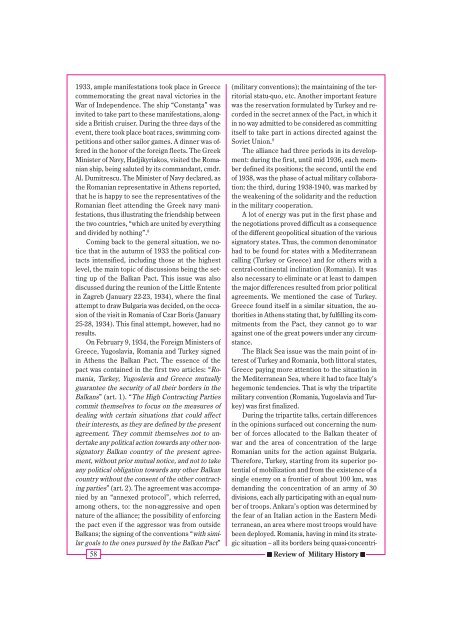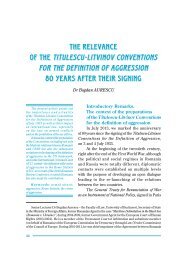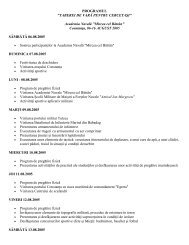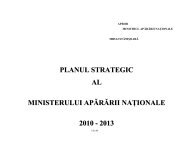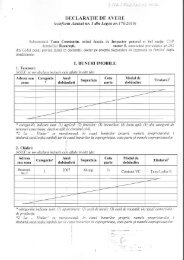You also want an ePaper? Increase the reach of your titles
YUMPU automatically turns print PDFs into web optimized ePapers that Google loves.
1933, ample manifestations took place in Greece<br />
commemorating the great naval victories in the<br />
War of Independence. The ship “Constanţa” was<br />
invited to take part to these manifestations, alongside<br />
a British cruiser. During the three days of the<br />
event, there took place boat races, swimming competitions<br />
and other sailor games. A dinner was offered<br />
in the honor of the foreign fleets. The Greek<br />
Minister of Navy, Hadjikyriakos, visited the Romanian<br />
ship, being saluted by its commandant, cmdr.<br />
Al. Dumitrescu. The Minister of Navy declared, as<br />
the Romanian representative in Athens reported,<br />
that he is happy to see the representatives of the<br />
Romanian fleet attending the Greek navy manifestations,<br />
thus illustrating the friendship between<br />
the two countries, “which are united by everything<br />
and divided by nothing”. 8<br />
Coming back to the general situation, we notice<br />
that in the autumn of 1933 the political contacts<br />
intensified, including those at the highest<br />
level, the main topic of discussions being the setting<br />
up of the Balkan Pact. This issue was also<br />
discussed during the reunion of the Little Entente<br />
in Zagreb (January 22-23, 1934), where the final<br />
attempt to draw Bulgaria was decided, on the occasion<br />
of the visit in Romania of Czar Boris (January<br />
25-28, 1934). This final attempt, however, had no<br />
results.<br />
On February 9, 1934, the Foreign Ministers of<br />
Greece, Yugoslavia, Romania and Turkey signed<br />
in Athens the Balkan Pact. The essence of the<br />
pact was contained in the first two articles: “Romania,<br />
Turkey, Yugoslavia and Greece mutually<br />
guarantee the security of all their borders in the<br />
Balkans” (art. 1). “The High Contracting Parties<br />
commit themselves to focus on the measures of<br />
dealing with certain situations that could affect<br />
their interests, as they are defined by the present<br />
agreement. They commit themselves not to undertake<br />
any political action towards any other nonsignatory<br />
Balkan country of the present agreement,<br />
without prior mutual notice, and not to take<br />
any political obligation towards any other Balkan<br />
country without the consent of the other contracting<br />
parties” (art. 2). The agreement was accompanied<br />
by an “annexed protocol”, which referred,<br />
among others, to: the non-aggressive and open<br />
nature of the alliance; the possibility of enforcing<br />
the pact even if the aggressor was from outside<br />
Balkans; the signing of the conventions “with similar<br />
goals to the ones pursued by the Balkan Pact”<br />
(military conventions); the maintaining of the territorial<br />
statu-quo, etc. Another important feature<br />
was the reservation formulated by Turkey and recorded<br />
in the secret annex of the Pact, in which it<br />
in no way admitted to be considered as committing<br />
itself to take part in actions directed against the<br />
Soviet Union. 9<br />
The alliance had three periods in its development:<br />
during the first, until mid 1936, each member<br />
defined its positions; the second, until the end<br />
of 1938, was the phase of actual military collaboration;<br />
the third, during 1938-1940, was marked by<br />
the weakening of the solidarity and the reduction<br />
in the military cooperation.<br />
A lot of energy was put in the first phase and<br />
the negotiations proved difficult as a consequence<br />
of the different geopolitical situation of the various<br />
signatory states. Thus, the common denominator<br />
had to be found for states with a Mediterranean<br />
calling (Turkey or Greece) and for others with a<br />
central-continental inclination (Romania). It was<br />
also necessary to eliminate or at least to dampen<br />
the major differences resulted from prior political<br />
agreements. We mentioned the case of Turkey.<br />
Greece found itself in a similar situation, the authorities<br />
in Athens stating that, by fulfilling its commitments<br />
from the Pact, they cannot go to war<br />
against one of the great powers under any circumstance.<br />
The Black Sea issue was the main point of interest<br />
of Turkey and Romania, both littoral states,<br />
Greece paying more attention to the situation in<br />
the Mediterranean Sea, where it had to face Italy’s<br />
hegemonic tendencies. That is why the tripartite<br />
military convention (Romania, Yugoslavia and Turkey)<br />
was first finalized.<br />
During the tripartite talks, certain differences<br />
in the opinions surfaced out concerning the number<br />
of forces allocated to the Balkan theater of<br />
war and the area of concentration of the large<br />
Romanian units for the action against Bulgaria.<br />
Therefore, Turkey, starting from its superior potential<br />
of mobilization and from the existence of a<br />
single enemy on a frontier of about 100 km, was<br />
demanding the concentration of an army of 30<br />
divisions, each ally participating with an equal number<br />
of troops. Ankara’s option was determined by<br />
the fear of an Italian action in the Eastern Mediterranean,<br />
an area where most troops would have<br />
been deployed. Romania, having in mind its strategic<br />
situation – all its borders being quasi-concentri-<br />
58 ����� Review of Military History �����


